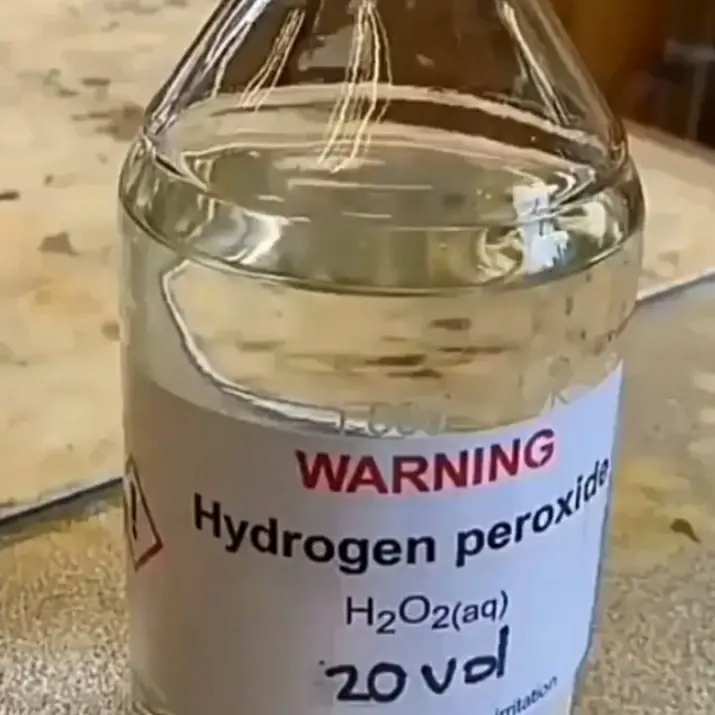Content :
Hydrogen Peroxide: Uses, Benefits, Safety, and Chemical Properties
Hydrogen peroxide (H₂O₂) is a versatile chemical compound widely used in medicine, disinfection, and industrial applications. Known for its oxidizing properties, it is a staple in many households and medical facilities. In this article, we explore the uses, benefits, safety precautions, and scientific properties of hydrogen peroxide.
Overview
Hydrogen peroxide is a clear, colorless liquid with a slightly sharp odor. It is a simple compound consisting of two hydrogen atoms and two oxygen atoms (H₂O₂). It is commonly available in various concentrations, with 3% being the most widely used for household and medical purposes.

Hydrogen peroxide V20
Common Uses of Hydrogen Peroxide
Hydrogen peroxide has a wide range of applications, including:
1. Medical and First Aid
- Wound Cleaning: Hydrogen peroxide is often used to clean minor cuts and scrapes due to its antiseptic properties.
- Mouthwash: Diluted hydrogen peroxide can be used as a mouthwash to kill bacteria and whiten teeth.
- Ear Wax Removal: A few drops of hydrogen peroxide can help soften ear wax for easier removal.
2. Household Cleaning
- Disinfectant: It is effective for disinfecting surfaces, kitchen tools, and bathroom fixtures.
- Stain Remover: Hydrogen peroxide can remove stains from clothing, carpets, and upholstery.
- Mold and Mildew Remover: It is useful for cleaning mold and mildew in bathrooms and kitchens.
3. Industrial Applications
- Bleaching Agent: Hydrogen peroxide is used in the textile and paper industries for bleaching.
- Water Treatment: It is employed in water treatment facilities to remove impurities and disinfect water.
Benefits of Hydrogen Peroxide in Medicine
Hydrogen peroxide offers several benefits in medical and clinical settings:
- Antiseptic Properties: It helps prevent infections by killing bacteria, viruses, and fungi.
- Wound Healing: When used correctly, it can promote faster healing of minor wounds.
- Teeth Whitening: Many people use hydrogen peroxide as a natural teeth whitening agent.
Note :
- This product should not be used to treat deep wounds, animal bites or severe burns.
- You can have acne treatments that contain benzoyl peroxide. But hydrogen peroxide and benzoyl peroxide are not the same. Do not use it for acne.
- This antiseptic is not suitable for the disinfection of scissors, razors and other potentially contaminating objects.
Safety Precautions and Risks
While hydrogen peroxide is generally safe when used properly, it is important to follow safety guidelines:
- Dilution: Always use the appropriate concentration for the intended use. For example, 3% for wound cleaning and higher concentrations only for industrial purposes.
- Avoid Ingestion: Swallowing hydrogen peroxide can cause serious health issues, including internal burns.
- Skin and Eye Irritation: Prolonged exposure can irritate the skin and eyes. Always wear gloves and avoid contact with eyes.
- Inhalation Risks: Inhaling high concentrations of hydrogen peroxide can damage the respiratory system.
Chemical Properties of Hydrogen Peroxide
Hydrogen peroxide is a powerful oxidizing agent with unique chemical properties:
- Molecular Formula: H₂O₂
- Molar Mass: 34.0147 g/mol
- Boiling Point: 150.2°C (302.4°F)
- Density: 1.45 g/cm³ (at 20°C)
- Decomposition: It decomposes into water and oxygen, making it environmentally friendly.
Hydrogen Peroxide Concentrations
◉ Hydrogen peroxide can have different strengths or concentrations, depending on the intended use. Concentrations are most often expressed as a percentage: 3%, 10%, 30%, etc. Sometimes the concentration is indicated by a "V" : V20, V40, etc. A concentration of 3% corresponds to V10.
◉ The term "10V = 10 volumes" means that one liter of solution can release 10 liters of active oxygen.
- Hydrogen peroxide concentrated at 3% (97% water and 3% peroxide): it is medical grade peroxide like hydrogen peroxide officinalis or in supermarkets.
- Concentrated hydrogen peroxide 6% to 10% : this is the concentration of some hair dyes and teeth whitening products
- Concentration of 35% : this is food grade peroxide. It is called "food grade" because the food industry uses it for several purposes, such as processing and bleaching certain foods.
- Up to 90% : the concentration in industrial products not intended for domestic use.
FAQs About Hydrogen Peroxide
1. Is hydrogen peroxide safe for wound care?
Yes, hydrogen peroxide can be used to clean minor wounds, but it should not be used on deep cuts or as a long-term treatment, as it can delay healing.
2. Can hydrogen peroxide be used for teeth whitening?
Yes, diluted hydrogen peroxide is commonly used in teeth whitening products. However, overuse can damage tooth enamel.
3. What are the risks of inhaling hydrogen peroxide?
Inhaling high concentrations of hydrogen peroxide can cause respiratory irritation, coughing, and shortness of breath. Always use it in a well-ventilated area.
4. How should hydrogen peroxide be stored?
Store hydrogen peroxide in a cool, dark place, away from direct sunlight and heat. Keep it in its original container with a tight-fitting lid.
Conclusion
Hydrogen peroxide is a versatile and valuable chemical compound with numerous applications in medicine, household cleaning, and industry. By understanding its uses, benefits, and safety precautions, you can make the most of this powerful substance. Always use it responsibly and follow recommended guidelines to ensure safety.